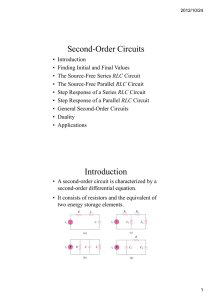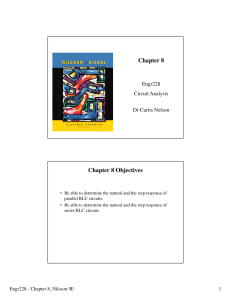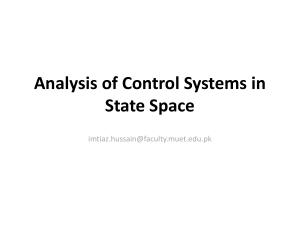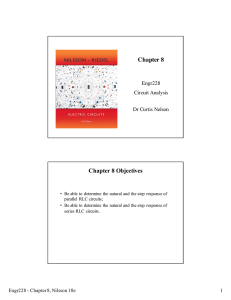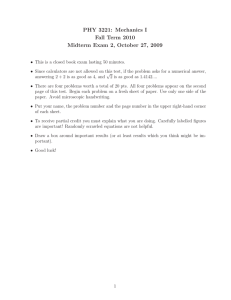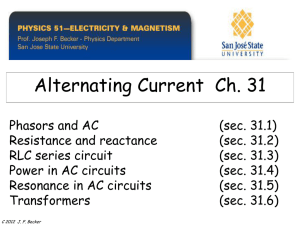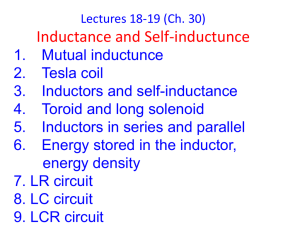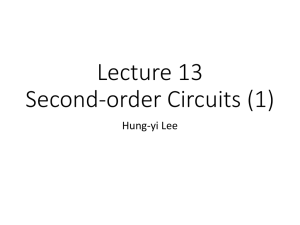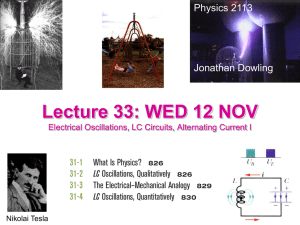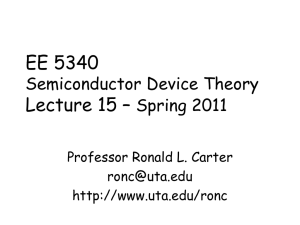Second-Order Circuit..
advertisement
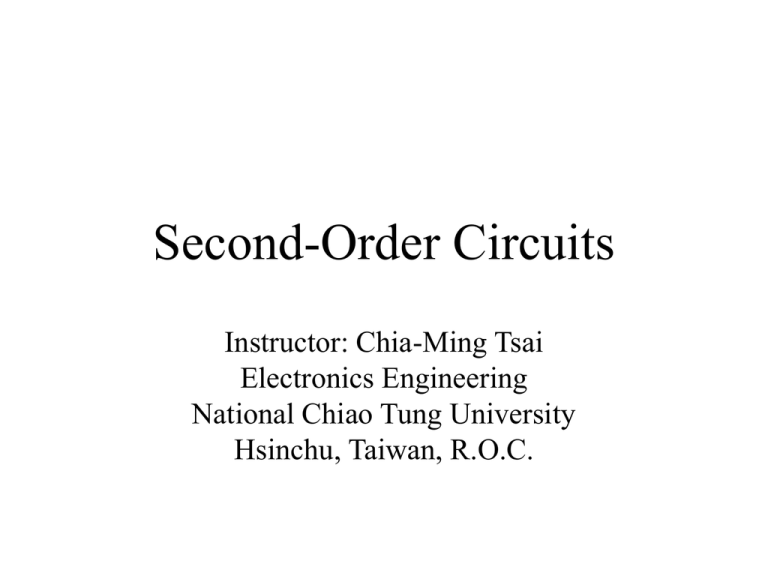
Second-Order Circuits Instructor: Chia-Ming Tsai Electronics Engineering National Chiao Tung University Hsinchu, Taiwan, R.O.C. Contents • • • • • • • • • Introduction Finding Initial and Final Values The Source-Free Series RLC Circuit The Source-Free Parallel RLC Circuit Step Response of a Series RLC Circuit Step Response of a Parallel RLC Circuit General Second-Order Circuits Duality Applications Introduction • A second-order circuit is characterized by a second-order differential equation • It consists of resistors and the equivalent of two energy storage elements Finding Initial and Final Values • v and i are defined according to the passive sign convention i _ v + • Continuity properties – Capacitor voltage – Inductor current vC (0 ) vC (0 ) iL (0 ) iL (0 ) Example Find (a) i (0 ), v(0 ), (b) di(0 ) dt , dv(0 ) dt , (c) i (), v(). Sol : (a) 12 i (0 ) 2A 42 v(0 ) 2i (0 ) 4 V i (0 ) i (0 ) 2 A v (0 ) v (0 ) 4 V Example (Cont’d) Sol : (b) iC (0 ) i (0 ) 2 A dv dv iC C iC , dt dt C dv(0 ) iC (0 ) 2 20 V/s dt C 0 .1 di di vL L vL , dt dt L T o obt ain vL , applyingKVL gives 12 4i (0 ) vL (0 ) v(0 ) 0 vL (0 ) 12 8 4 0 di(0 ) vL (0 ) dt L 0 0 A/s 0.25 Example (Cont’d) Sol : (c) i ( ) 0 A v() 12 V The Source-Free Series RLC Circuit Assumed initial conditions: i 0 I 0 v 0 1 0 idt V 0 C C Applying KVL gives di 1 t Ri L idt 0 dt C d 2i R di i 2 0 dt L dt LC (1) and (2) gives di(0) Ri(0) L V0 0 dt di(0) 1 RI0 V0 dt L (1a) (1b) (2) (3) (4) d 2i R di i 0 2 dt L dt LC Init ial condit ions: i 0 I 0 di(0) 1 RI V 0 0 dt L Cont’d d 2i R di i 0 2 dt L dt LC Initial conditions: i 0 I 0 di(0) 1 RI V 0 0 dt L Let i Aest : A and s are constants AR st A st 2 st As e se e 0 L LC R 1 st 2 Ae s s 0 L LC R 1 Characteristic s2 s 0 equation L LC 2 s1 R 1 R 2L 2 L LC 2 s2 R 1 R 2L 2 L LC s 2 2 Natural 1 0 2 2 s2 0 frequencies R Damping factor 2L where 1 Resonant 0 LC frequency Summary s 2 2 1 0 2 2 s 2 0 R 2 L where 1 0 LC T wo solutions (if s1 s2 ) : i1 A1e , i2 A2 e s1t s2t A general solution: i (t ) A1e s1t A2e s2t • Three cases discussed – Overdamped case – Critically damped case – Underdamped case : > 0 : = 0 : < 0 Overdamped Case ( > 0) R 1 4L C 2 2L R LC Both s1 and s2 are negative and real. i(t ) A1e s1t A2 e s2t i(t) e s1t e s2t t Critically damped Case ( = 0) C 4L R 2 s1 s2 L 2 R di Let f i dt df t t t f 0 f A1e t i (t ) A1e A2 e A3e dt Single constantcan't satisfy two init ial di t i A e 1 condit ions! dt t di e eti A1 dt Back totheoriginaldifferential equation. d t d 2i di e i A1 2 2 i 0 dt dt 2 dt t e i A1t A2 d di di i i 0 t i ( t ) A t A e 1 2 dt dt dt Critically damped Case (Cont’d) i(t ) A1t A2 e t i(t) e t te 1 t t Underdamped Case ( < 0) C 4L R 2 s 2 2 j 1 0 d 2 2 s2 0 jd where d 02 2 i (t ) B1e ( jd ) t B2 e ( jd )t e t ( B1e jd t B2 e jd t ) e t B1 cosd t j sin d t B2 cosd t j sin d t e t B1 B2 cosd t j B1 B2 sin d t i (t ) e t A1 cosd t A2 sin d t A1 B1 B2 where A2 j B1 B2 Underdamped Case (Cont’d) i(t ) A1 cosd t A2 sin d t e i(t) e t t 2 d t Finding The Constants A1,2 T o determineA1 and A2 , we need i (0) and di(0) /dt. i ( 0) I 0 di(0) RI0 V0 0 L dt di(0) 1 ( RI0 V0 ) or dt L Conclusions • The concept of damping – The gradual loss of the initial stored energy – Due to the resistance R • Oscillatory response is possible – The energy is transferred between L and C – Ringing denotes the damped oscillation in the underdamped case • With the same initial conditions, the overdamped case has the longest settling time. The critically damped case has the fastest decay. Example Find i(t). t<0 t>0 Example (Cont’d) t<0 10 1 A, v(0) 6i (0) 6 V 46 R 1 1 α 9, ω0 10 2L LC 0.01 t>0 i (0) Init ialcondit ions: s1,2 α α 2 ω02 9 81 100 i( 0 ) 1 di(0) 1 dt L Ri(0) v(0) 29(1) 6 6 9 j 4.359 i (t ) e 9t A1 cos 4.359t A2 sin 4.359t A1 1 A2 0.6882 The Source-Free Parallel RLC Circuit Assumed init ial condit ions: 1 0 i 0 I 0 v(t)dt L v0 V0 Applying KCL gives (1a) (1b) v 1 t dv vdt C 0 (2) R L dt d 2v 1 dv v 2 0 (3) dt RC dt LC Let v(t) Aest , t he charact erist ic equat ion becomes 1 1 2 s s 0 RC LC s1, 2 2 02 1 2 RC where 1 0 LC Summary : > 0 • Overdamped case v(t ) A1e A2e s1t s 2t • Critically damped case v(t ) A1 A2t et • Underdamped case s1, 2 jd : = 0 : < 0 where d 02 2 v(t ) e t A1 cosd t A2 sin d t Finding The Constants A1,2 T o determineA1 and A2 , we need v(0) and dv(0) /dt. v(0) V0 V0 dv(0) 0 I0 C R dt (V0 RI0 ) dv(0) or RC dt Comparisons • Series RLC Circuit • Parallel RLC Circuit s1, 2 2 02 s1, 2 2 02 R 2 L where 1 0 LC Init ial condit ions: 1 2 RC where 1 0 LC Initial conditions: i (0) I 0 di(0) V0 RI0 dt L v(0) V0 dv(0) V0 RI0 dt RC Example 1 Find v(t) for t > 0. v(0) = 5 V, i(0) = 0 Consider three cases: R = 1.923 R=5 R =6.25 Case 1 : R 1.923 1 α 26, ω0 2 RC Initialconditions: 1 10 LC s1,2 α α 2 ω02 2, 50 v(t ) A1e 2t A2 e 50 t v(0) 5 dv(0) v(0) Ri(0) 260 dt RC A1 0.2083 A2 5.208 Example 1 (Cont’d) Case 2 : R 5 1 α 10, ω0 2 RC Initialconditions: 1 10 LC s1,2 α α 2 ω02 10 v(t ) A1 A2t e 10t Case 3 : R 6.25 1 α 8, ω0 2 RC v(0) 5 dv(0) v(0) Ri(0) 100 dt RC A1 5 A2 50 Initialconditions: 1 10 LC s1,2 α α 2 ω02 8 j 6 v(t ) A1 cos6t A2 sin 6t e 8t v(0) 5 dv(0) v(0) Ri(0) 80 dt RC A1 5 A2 6.667 Example 1 (Cont’d) Example 2 Find v(t). Get x(0). Get x(), dx(0)/dt, s1,2, A1,2. t<0 t>0 Example 2 (Cont’d) t>0 1 α 2 RC 500 ω0 1 354 LC s1,2 α α 2 ω02 854, 146 v(t ) A1e 854 t A2 e 146 t t<0 From t heinit ialcondit ions: 50 v(0) 30 50 (40) 25 V i (0) 40 0.5 A 30 50 dv(0) v(0) Ri(0) 25 50 0.5 0 dt RC 50 20 106 A1 5.156 A2 30.16 Step Response of A Series RLC Circuit Applying KVL for t 0, di Ri L v VS (1) dt dv But i C dt VS d 2 v R dv v 2 (2) dt L dt LC LC v(t ) vt (t ) vss (t ) where (2) has t hesame formas in t hesource - free case. vt : the t ransientresponse vss : thest eady - st ateresponse Characteristic Equation d 2 v R dv v VS 0 2 dt L dt LC Let v ' v VS , d 2 v ' R dv' v ' 2 0 dt L dt LC T hecharacterist ic equation becomes R 1 2 s s 0 L LC Same as in thesource - free case. Summary v(t ) vt (t ) vss (t ) vss (t ) v() VS (Overdamped) A1e s1t A2 e s2t t (Critically damped) vt (t ) A1 A2t e A cos t A sin t e t (Underdamped) d 2 d 1 where A1, 2 are obtained from v(0) and dv(0) /dt. Example Find v(t), i(t) for t > 0. Consider three cases: R=5 R=4 R =1 Get x(0). t<0 Get x(), dx(0)/dt, s1,2, A1,2. t>0 Case 1: R = 5 vss v() 24 V R 5 α 2 L 2(1) 2.5 ω 1 2 0 LC Initialconditions: s1,2 α α 2 ω02 1, 4 v(t ) vss A1e t A2 e 4t dv i (t ) C dt 24 i (0) 5 1 4 A , v(0) 1i (0) 4 V dv(0) dv(0) 4 i (0) C 16 dt dt C A1 64 3 A2 4 3 Case 2: R = 4 R 4 α 2 L 2(1) 2 ω 1 2 0 LC s1,2 α 2 v(t ) vss A1 A2t e 2t i (t ) C dv dt vss v() 24 V Init ialconditions: 24 i (0) 4 1 4.8 A , v(0) 1i (0) 4.8 V dv(0) dv(0) 4.8 i (0) C 19.2 dt dt C A1 19.2 A2 19.2 Case 3: R = 1 R 1 α 0.5 2 L 2(1) ω 1 2 0 LC s1,2 0.5 j1.936 A1 cos1.936t 0.5t e v(t ) vss A2 sin 1.936t dv i (t ) C dt vss v() 24 Initialconditions: 24 i ( 0 ) 12 A , v(0) 1i (0) 12 V 11 dv(0) dv(0) 12 i (0) C 48 dt dt C A1 12 A2 21.694 Example (Cont’d) Step Response of A Parallel RLC Circuit Applying KCL for t 0, v dv iC IS (1) R dt di But v L dt IS d 2i 1 di i 2 (2) dt RC dt LC LC (2) has t hesame formas in t hesource - free case. i (t ) it (t ) iss (t ) where it : t he t ransientresponse iss : t hesteady - stat eresponse Characteristic Equation d 2i 1 di i I S 0 2 dt RC dt LC Let i ' i I S , d 2i ' 1 di' i' 2 0 dt RC dt LC T hecharacterist ic equation becomes 1 1 2 s s 0 RC LC Same as in thesource - free case. Summary i (t ) it (t ) iss (t ) iss (t ) i () I S A1e s1t A2 e s2t (Overdamped) t (Critically damped) it (t ) A1 A2t e A cos t A sin t e t (Underdamped) d 2 d 1 where A1, 2 are obtained from i (0) and di(0) /dt. General Second-Order Circuits • Steps required to determine the step response – Determine x(0), dx(0)/dt, and x() – Find the transient response xt(t) • Apply KCL and KVL to obtain the differential equation • Determine the characteristic roots (s1,2) • Obtain xt(t) with two unknown constants (A1,2) – Obtain the steady-state response xss(t) = x() – Use x(t) = xt(t) + xss(t) to determine A1,2 from the two initial conditions x(0) and dx(0)/dt Example Find v, i for t > 0. Get x(0). Get x(), dx(0)/dt, s1,2, A1,2. t<0 t>0 Example (Cont’d) t<0 Initialconditions: v(0 ) v(0 ) 12 V (1a) i (0 ) i (0 ) 0 (1b) ApplyingKC at node a (t 0), v (0 ) i (0 ) iC (0 ) 2 iC (0 ) 6 A t>0 dv(0 ) iC (0 ) 12 V/s (1c) dt C Final values for t : 12 i ( ) 2A 42 v() 2i () 4 V Example (Cont’d) ApplyingKCL at node a gives v 1 dv i (2) 2 2 dt ApplyingKVL to theleft mesh gives dv 4i 1 v 0 (3) dt Substituting (2) into(3) gives dv 1 dv 1 d 2 v 2v 2 v 0 2 dt 2 dt 2 dt d 2v dv 2 5 6v 0 (4) dt dt Characteristic equation: s 2 5s 6 0 t>0 s 2, 3 v(t ) vss vt (t ) vss v() 4 where 2t 3t v ( t ) A e A e 1 2 t From (1a) and (1c) we obtain A1 12, A2 8 i (t ) can be obtain by using (2) Duality • Duality means the same characterizing equations with dual quantities interchanged. Table for dual pairs Resistance R Inductance L Conductance G Capacitance C Voltage v Voltage source Node Series path Current i Current source Mesh Parallel path Open circuit KVL Thevenin Short circuit KCL Norton Example 1 • Series RLC Circuit • Parallel RLC Circuit R 1 s s 0 L LC 1 1 s s 0 RC LC 2 2 Example 2 Application: Smoothing Circuits Output from a D/A vs v0
